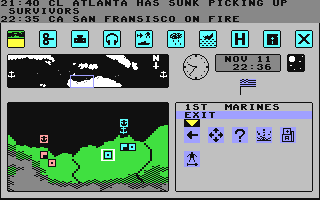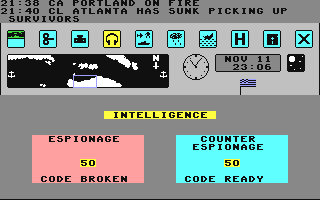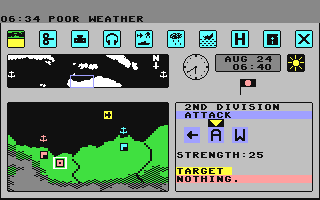|
Guadalcanal
describes itself as 'a comprehensive strategy game'.
The end result is interesting and innovative, if not
one hundred percent successful.
The
invasion of the island of Guadalcanal by the American
marines was the first offensive Allied move in the Pacific
after the capture of Midway Island. It began with the
capture of a single Japanese base with a half-completed
airfield, which had been garrisoned only by engineers,
who fled leaving their hot rice breakfasts behind. The
American invaders completed the airfield, ate the rice
-- apparently the Japanese supplies became 'invaluable'
-- and called the base Henderson. In the game it's the
American player's only definite foothold, and the place
where supplies are brought to and distributed from.
The battle for control of the rest of the island continued
thereafter for months, and was fought on land, at sea,
and in the air. Supply runs were vital to both sides,
and slowly the American presence expanded enough to
resist the customary massive Japanese onslaughts. After
a complex war of attrition, lasting from August 1942
to January of the following year, the Japanese retreated
in secret and the island was conceded to the Allies.
Given
that this is a pretty full recreation of a campaign
that lasted six months, it's very surprising to find
that the game is set in real-time. I have expressed
my dislike of real-time wargames before -- they tend
to be shallow and unplayable and lacking in atmosphere
-- but Guadalcanal runs at such an extremely
slow pace that the time very nearly is real, and issuing
orders quickly enough is not a problem. I can see some
justification for using real-time in this game, because
the many different things going on at once are all running
at their own pace. The timescale is at least accurate.

There
are no difficulty levels, but a 'trainer' game is provided
to let the player learn how to control the units without
inconvenient Japanese forces getting in the way. The
playability of such a peaceful scenario is limited,
so there's another introductory battle, short of the
full campaign. The rulebook says that this short three-day
confrontation is intended to let the player get combat
experience. It consistently provided me with a humiliating
defeat. Scenario three is the entire Guadalcanal campaign,
though whether it lasts for six months of slow-moving
real-time or waits for either side to achieve a victory
condition is not made clear. Scenario four is the same
campaign, giving the player the opportunity to command
the Japanese forces instead of the American. All are
loaded separately from disk or cassette.
Without
further preliminary the game starts with a single well-designed
screen subdivided into windows and panels. A bank of
ten 'master icons' guide the action. Displays of active
units and their condition, weather reports, and naval
losses are selected separately and there are icons to
pause, save and quit the game. Only two icons relate
directly to play and allow the selection of scouts and
the distribution of points between espionage and counter
espionage.
Most
of the controlling action takes place on the map itself,
which fills just over a quarter of the whole screen
display. It competes for space with a long narrow strategic
map of the entire area of play, a large information
window, and a well-equipped panel which shows the date
and the time in both digital and analogue form, the
side that the player is controlling and the current
'phase'. Days cycle through dawn, daylight, dusk and
night.

The
play area takes in the island of Guadalcanal itself
and the surrounding seas. Other landmasses are unidentified
and have no part in the game. Units are displayed as
very small and sometimes not entirely clear squares,
visually divided only into naval, infantry and airforce
divisions. This is confusing, because the distinction
between the different types of naval groups is important.
There are escort groups, carrier groups and transport
groups, which perform vital and distinctive roles in
running supplies to the island.
The
land units on the American side consist mainly of Marine
Corps. They have a full range of defining statistics,
including their level of arms, ammunition, supply, morale
and malaria. Malaria is a major enemy on the island,
and is capable of destroying forces quite as efficiently
as Japanese guns. The malaria level of a unit increases
naturally the longer it is on the island, and can only
be kept under control by the issue of medical supplies.
Morale affects combat significantly, and can be boosted
by general supplies and rest. Arms and ammunition are
used up in battle and must be replaced.
In
the campaign game, hidden movement is used to a great
extent and the player has a stable of six scouts of
varying ability to send out one at a time on reconnaissance
missions. These intrepid individuals cut through the
thick bush in search of Japanese camps and report back
with the enemy's location, though they're in constant
danger of getting caught and bayonetted to a tree.

Air
forces play a full role too. Some of the naval groups
have aircraft carriers with their own planes, and Henderson
has an air division known as the Cactus Air Force. Aircraft
can only be launched during daylight hours, and carry
a strictly limited amount of fuel and ammunition --
sending them out too far from base is fatal. They can
bomb enemy units and bases, and in the campaign scenario
the Japanese are very keen to use their air units against
the American navy.
With
all these different elements competing for the player's
attention, it's fortunate that play itself is not very
complex. Units are ordered to move in a particular direction
and to attack or withdraw -- and that's it. Giving these
orders by means of a command box is reasonably straightforward
and painless, and because time advances slowly there's
plenty of chance to do everything properly. There's
a master icon provided for running the clock forward,
and far from being rushed off my fingers I found I often
had to speed things up.
Combat
is seriously underrepresented. When a fleet is attacked,
the 'radio', a strip of scrolling messages, informs
the player that ships are either on fire or have sunk.
When the sea battles get underway there's a constant
stream of 'ship on fire' messages, which are rather
frustrating because there's absolutely nothing that
can be done about it, short of running away. Fires on
ships will eventually be put out if they don't sink
first, but the damage remains until the fleet is dragged
slowly to one of the supply points.
A
lot of care and detail has gone into this game -- perhaps
too much. It's irritating having to drop and weigh the
ship's anchor every time you go into harbour. It's an
interesting experience to play, but I found it difficult
to get into the swing of. I may have been doing something
stupid, but despite the designer's injunctions that
warships were priceless and were not casually thrown
en masse against the Japanese fleets, I found that it
was impossible to avoid disastrous sea battles. I did
my best to be cautious, but the Japanese units made
straight for the fray and shot everything in sight.
What was particularly infuriating was the fact that
they seemed to go down less easily than my highly inflammable
fleet!
|